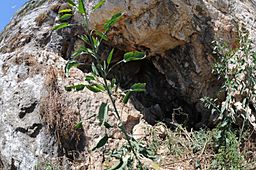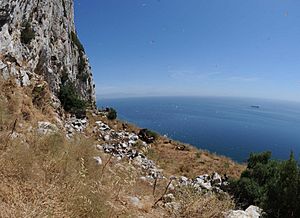Ibex Cave facts for kids
Quick facts for kids Ibex Cave |
|
|---|---|

Entrance to Ibex Cave.
|
|
| Location | Eastern face of the Rock of Gibraltar, Gibraltar |
| Discovery | 1975 |
| Geology | Limestone |
| Entrances | 1 |
Ibex Cave is a special limestone cave found on the Rock of Gibraltar. It's famous because scientists found ancient stone tools from the Paleolithic age there. These tools were made by Neanderthals, who lived thousands of years ago.
The cave was first discovered in 1975. It got its name, Ibex Cave, because a skull of an ibex (a type of wild mountain goat) was found inside. Neanderthals likely hunted these animals for food. The Gibraltar Museum officially named and started digging at the cave in 1994. Its first detailed description was written in 1999.
Contents
Discovering Ibex Cave

The Gibraltar Museum began digging at Ibex Cave in 1994. Before this, people were collecting sand from the eastern side of the Rock of Gibraltar. This sand was used for building.
How the Cave Was Found (and Found Again!)
In 1985, workers were removing sand from the slopes. They found the entrance to a small cave. Inside, they found stone tools and animal bones. A person from the Public Works Department, George Palao, told them to stop. He collected the items and had the cave sealed up.
Years later, in 1991, Professor Clive Finlayson, who leads the Gibraltar Museum, found these items. They were in a bag in a museum vault. The bag held stone tools, mostly made of red jasper, and many animal bones. One important find was an almost complete skull of an ibex, a wild mountain goat. Mr. Palao's report was also in the bag. This report helped them figure out where the items came from.
The stone tools were from the Paleolithic period, meaning they were made by Neanderthals. A museum helper, Julio Gafan, knew about the find. He introduced Professor Finlayson to one of the workers who had found the cave. This worker agreed to show them the exact spot.
The Journey to the Cave
Professor Finlayson and his wife, Dr. Geraldine Finlayson, wrote about their trip to find the cave again. Getting there was not easy! They drove part of the way through the Waterworks tunnels. These tunnels lead to huge underground reservoirs that hold Gibraltar's water.
After leaving the car, they walked through a long tunnel. At the end, they saw the bright blue Mediterranean Sea. The eastern side of the Rock felt like a different world. The sun was warm, and they could see Catalan Bay below. The slopes were covered with different plants.
They walked along a path that used to carry rainwater. Stones would sometimes fall from the cliffs above. Soon, they had to climb up towards the cliff face. The steps were narrow, and some railings were not safe to hold. It was a challenging climb, especially for anyone afraid of heights.
Reaching the Discovery Site
After climbing about 700 steps, they reached a sandy area. This spot had been created by the workers who removed sand. They looked around and saw many tobacco plants growing. There was even a bulldozer that had been brought up in pieces and put together there!
The most dangerous part was getting from this sandy area to the cave. There were many large rocks left over from the sand removal. The cave was a small opening on the side of the cliff. When they reached it, they quickly found more ancient stone tools and bones on the surface. They knew this was a very important discovery. They decided they had to dig there.
Naming the Cave
The cave needed a name. Professor Finlayson and his team debated many names. Then, his nine-year-old son, Stewart, suggested something simple. Since they found a complete ibex skull, he said it should be called Ibex Cave.
At first, his parents weren't sure. But months later, another expert, Andy Currant, agreed. He said, "Stewart named it Ibex Cave, here is the Ibex skull, therefore you must call it Ibex Cave!" No one could argue with that! Two years later, in May 1994, the digging began.
What Was Found in Ibex Cave
We now know that Ibex Cave was a special place for Neanderthals about 40,000 years ago. It was likely a "hunting station." This means they went there to hunt ibexes. Besides ibexes, scientists also found bones of other animals. One interesting find was the now rare bearded vulture, also called a lammergeyer (Gypaetus barbatus).

